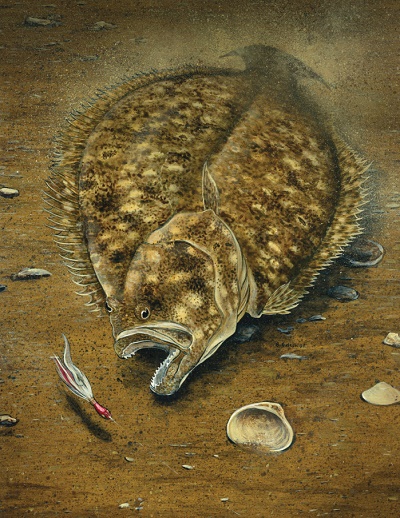NJ Saltwater Fishing Articles
- Details
- Category: Fishing Articles
- Published: Saturday, 27 February 2016 14:51
- Hits: 35163
The ocean and its marine creatures has always been a source of great amazement to me. Learning the science behind our fisheries has always been an asset to me no matter what I am fishing for. The purpose here is to introduce some of the known science that impacts our ability to capture a trophy sized fluke.
Migration:
 It is always wise to try to understand the migration pattern of any species you target. Right now a majority of the fluke population is offshore, mostly just inshore of the canyon edges anywhere from 40 to 85 miles offshore. Fluke spawn offshore in these deep waters where they will spawn several times during the course of their offshore foray, mostly in the early winter months. The young spawned will move inshore in the early spring where they will reach the backwaters and shallow bay areas where they can mature and feed. These young fluke will remain inshore and not migrate offshore until they are 1-2 years old. The adults begin to move inshore in very early March with some of the adults migrating into the bays and backwaters. While most folks think all of the fluke migrate way inshore as stated above, a majority of the fluke stay out in the ocean and never move inshore.
It is always wise to try to understand the migration pattern of any species you target. Right now a majority of the fluke population is offshore, mostly just inshore of the canyon edges anywhere from 40 to 85 miles offshore. Fluke spawn offshore in these deep waters where they will spawn several times during the course of their offshore foray, mostly in the early winter months. The young spawned will move inshore in the early spring where they will reach the backwaters and shallow bay areas where they can mature and feed. These young fluke will remain inshore and not migrate offshore until they are 1-2 years old. The adults begin to move inshore in very early March with some of the adults migrating into the bays and backwaters. While most folks think all of the fluke migrate way inshore as stated above, a majority of the fluke stay out in the ocean and never move inshore.
Fluke can be caught in the inshore waters as early as March with many astute anglers targeting and releasing them well before the season opens where fluke can be retained. Fluke will feed in the backwaters and bay waters from them until the water temps rise too high in the summer. Despite the abundance of bait in that venue, a majority of the fluke first shift to deeper pools and channels, then towards the inlet, then out to the oceanic feeding stations. (A need for all species of fish to stay in their water temperature tolerances is a primary driver of species migrations.)Some very large fluke, however, will continue to feed in the backwaters well into the summer and fall.
By mid summer and into the early fall, most of the fluke will be on the near shore reefs, wrecks, coral beds, and other structured areas. The backwater fish migrating out to the near shore grounds join the larger segment of the fluke that never migrated that far inshore in those areas. As we get into early September the fluke begin to leave the near shore structures and work their way out to structured areas further offshore and eventually out to the winter spawning grounds. So this is the basic pattern, an east-west migration, but interesting variations do occur.
A water world vs an air world: Learn to get into the mind of a Fluke Click Here to Read Full Article







